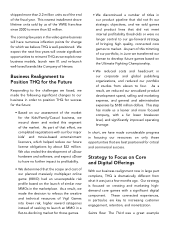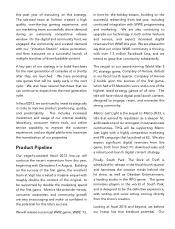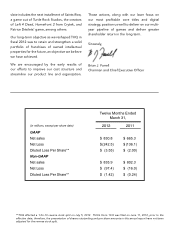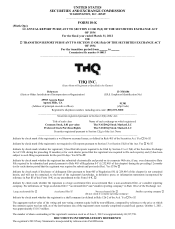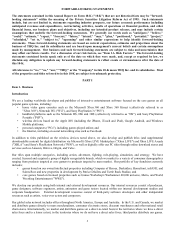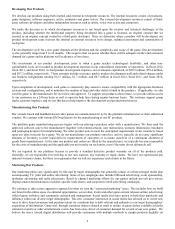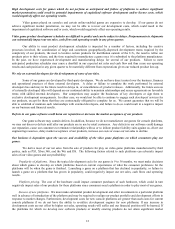THQ 2012 Annual Report Download - page 14
Download and view the complete annual report
Please find page 14 of the 2012 THQ annual report below. You can navigate through the pages in the report by either clicking on the pages listed below, or by using the keyword search tool below to find specific information within the annual report.6
Developing Our Products
We develop our products using both internal and external development resources. The internal resources consist of producers,
game designers, software engineers, artists, animators and game testers. The external development resources consist of third-
party software developers and other independent resources such as artists, voice-over actors and composers.
We make the decision as to which development resources to use based upon the creative and technical challenges of the
product, including whether the intellectual property being developed into a game is licensed, an original concept that we
created, or an original concept created by a third-party developer. Once we determine where a product will be developed, our
product development team oversees the internal or external resources in its design, technical assessment and construction of
each game.
The development cycle for a new game depends on the platform and the complexity and scope of the game. Our development
cycles generally range from 9 to 36 months. This requires that we assess whether there will be adequate retailer and consumer
demand for a game and its platform well in advance of its release.
The investments in our product development, prior to when a game reaches technological feasibility, and other non-
capitalizable costs, are recorded as product development expenses in our consolidated statements of operations. In fiscal 2012,
fiscal 2011, and fiscal 2010, we had product development expenses, net of amounts capitalized, of $89.5 million, $79.4 million,
and $87.2 million, respectively. These amounts include severance paid to product development staff and related charges under
our business realignments totaling $12.3 million, $1.7 million, and $0.7 million in fiscal 2012, fiscal 2011, and fiscal 2010,
respectively.
Upon completion of development, each game is extensively play-tested to ensure compatibility with the appropriate hardware
systems and configurations, and to minimize the number of bugs and other defects found in the products. If applicable, we also
send the game to the manufacturer for its review and approval. To support our products after release, we provide online access
to our customers on a 24 hour basis as well as operator help lines during regular business hours. The customer support group
tracks customer inquiries, and we use this data to help improve the development and production processes.
Manufacturing Our Products
Our console-based and handheld-based video games are manufactured for us by the platform manufacturers or their authorized
vendors. We contract with various DVD replicators for the manufacturing of our PC products.
The platform game manufacturing process begins with our placing a purchase order with a manufacturer. We then send the
approved software code to the manufacturer (together with related artwork, user instructions, warranty information, brochures
and packaging designs) for manufacturing. We order product units to meet the anticipated requirements of our customers, based
upon our sales forecasts for a game. We do not manufacture our products ourselves, and we typically do not carry significant
amounts of inventory to meet rapid delivery requirements of customers or to assure ourselves of a continuous allotment of
goods from manufacturers. At the time our product unit orders are filled by the manufacturer, we typically become responsible
for the costs of manufacturing and the applicable per unit royalty on such units, even if the units do not ultimately sell.
We are required by our platform licenses to provide a standard defective product warranty on all of the products sold.
Generally, we are responsible for resolving, at our own expense, any warranty or repair claims. We have not experienced any
material warranty claims, but there is no guarantee that we will not experience such claims in the future.
Marketing Our Products
Our marketing plans vary significantly by title and by target demographic but generally consist of a three-pronged media plan
encompassing TV, print and online advertising. Some of our campaigns also include billboard advertising, event sponsorship,
in-theater advertising and radio placements. Retail or channel marketing efforts for our games include pre-sell give-aways,
displays and/or demonstrations at retailer-specific trade shows, and cooperative retail advertising campaigns.
We continue to take a more aggressive approach in what we term the "connected marketing" space. This includes how we build
our brand in the online space via editorial opportunities; screen shot, trailer and other game content releases online; advertising;
official game websites; and community outreach and management. Social media sites have grown in both their popularity and
influence within our diverse target demographic. This new consumer immersion in social media has allowed us to create new
ways to drive brand awareness and purchase intent via a medium that is both relevant and authentic to our target demographics'
acquisition of information. Game trial, through consumer demos released at retail or online, or game demos available at kiosks
stationed at sports or other entertainment events, has been a key driver of consumer demand for several of our core games. We
believe the move toward digital distribution will provide consumers with multiple methods to sample products digitally (at


